Originally a Norse settlement, Roby appears in the Domesday Book as ‘Rabil’ at which time it was one of the manors held by Uctred. The name means boundary farm. It was part of the West Derby Hundred and as with many of the surrounding townships became part of the Barony of Widnes in 1351 and subsequently merged into the Duchy of Lancaster.
The manor was held by the de Lathom family, and although they were based at Knowsley, they did make numerous attempts to develop and extend Roby. Robert de Lathom founded Burscough Priory in the late 12th century, and his namesake in 1304 was granted the right to hold a market and fair in the township, but this seems to have declined in the mid 1320s after Prescot was granted its own market. In 1372 there was an attempt to establish Roby as a borough, but again this was ultimately unsuccessful. A few years later Isabel, the daughter of Sir Thomas Lathom married Sir John de Stanley and the lands were divided between the Stanley and Harrington families.
The medieval village of Roby was clustered around the crossroads of what is today Station Road, Roby Road and Carr Lane. In the centre was the Cross, the exact date or purpose of which remains unclear, although it has also been called the Market Cross, Stocks Cross (from the stocks which were in front of it until the early 19th century) and the Boundary Stone. For many years it had the impressive Edenhurst Cottages for a backdrop.
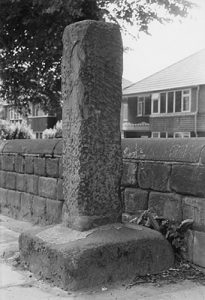

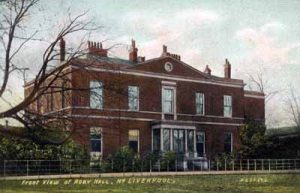
Roby Old Hall, was known as Bury Hall in the 16th century after the family who lived there. In 1761, John Williamson, Mayor of Liverpool, built a new Roby Hall to the south-west of the Old Hall, and both buildings feature on later Ordnance Survey maps.
It is likely that the township remained basically unchanged until the introduction of turnpike roads in 1726, with the road between Liverpool and Prescot passing through Roby. This brought an increasing volume of traffic through the township, forcing the route to be altered on a number of occasions. Two houses were built for the collection of tolls, one of which Toll Bar Cottage, is still a prominent feature of the township today.
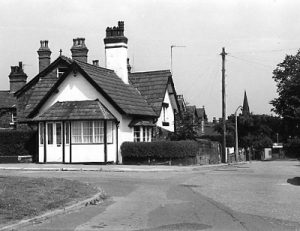
Further change was not far behind with the construction of the Liverpool-Manchester railway. The original route, proposed by George Stephenson in 1825, ran through both the Croxteth and Knowsley Estates and was heavily opposed by the Earls of Sefton and Derby respectively. Stephenson was replaced by Charles Vignoles, who advocated an alternative route via Huyton and Roby and which bypassed these Estates.
Stephenson was re-instated as chief engineer and the revised route took less than three years to build, being officially opened in September 1830 by the Prime Minister, the Duke of Wellington.
The railway attracted new housing developments, including Edenhurst which was built in 1840 by Edward Stanley (who later became the 14th Earl of Derby) for his estate manager and close friend, Richard Earle. When Earle died a few years later Edward Stanley, with further donations from Ellis Ashton (the vicar at Huyton), decided to build St. Bartholomew’s Church in memory of his friend. It was built in 1850, a tower being added in 1853, but in 1875 it was extensively rebuilt, the spire being completed the following year.


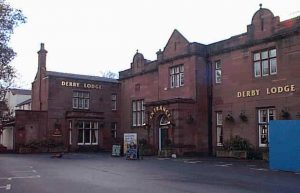
Edenhurst has seen a number of changes of use, it served for a time as a residential home but more recently and for many years has been the Derby Lodge Hotel.
An improvement in transport in the area was made in 1915 when a tramway route between Edge Lane, Liverpool and Bowring Park opened. For over 40 years this tram route continued to run and when the 6A tram made its final journey on 15th September 1957, crowds turned out to mark the event.

The 1930s was a period of considerable growth and development, with a number of housing estates being built on the fringes between Huyton and Roby, as Liverpool City Corporation sought to reduce its waiting list. With the Fincham, Page Moss and Sunnyside estates being built in a matter of years, the scale and impact was huge. The number of inhabited houses rose from 1236 (in 1931) to 8619 (in 1938) and in the same period, the population increased from 5,368 to 29,500.
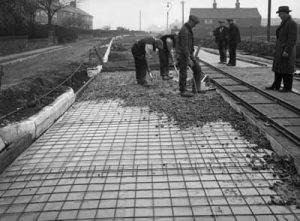
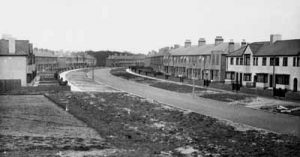
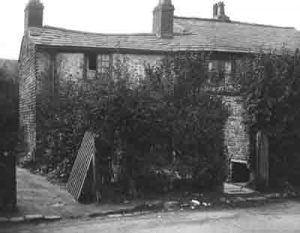
These figures would have been much higher had it not been for the outbreak of the Second World War. The increased housing required an extensive overhaul of the infrastructure and by the mid 1930s, work had begun on the construction of Kingsway, the outer circle road and the widening of Dinas Lane and Twig Lane. Such extensive work inevitably resulted in the loss of some older properties and the opportunity was used to remove some of the worst areas of poor housing denoted as Clearance Areas.
During the war, and in particular in the week of the May Blitz in 1941 hundreds of people sought refuge from the bombs in Bowring Park (formerly Roby Hall Estate), returning to their houses the next morning. The Hall had been bequeathed in 1906 by William Benjamin Bowring, the city’s first elected Lord.
Consisting of over 100 acres, a mansion and some cottages, it was offered to the Corporation for the use of the inhabitants of Liverpool for all time. In 1913, part of the grounds was in use as the first municipal golf course in England. Additionally in 1921, the old English gardens were opened to the public. Although the Hall itself was demolished in the early 1950s, the land and gardens, which had been cultivated during the war were restored by the Corporation. In 1980s, the gardens were sold by Liverpool City Council. In June 1997 the park was taken-over by Knowsley Metropolitan Borough Council with a view to an application to the Heritage Board to assist in restoration of the park and to develop the golf course.
During 1960s, the volume of traffic passing through the village necessitated the widening and straightening of Roby Road, and as a result, Edenhurst Cottages were demolished and Roby Cross was moved to its current position near Station Road. In 1975 the M62 motorway was opened cutting through part of the Bowring Estate.

Since the late nineteenth century Roby has been overseen in conjuction with Huyton for administrative reasons. This became formalised with the two townships being referred to as one under the name Huyton-with-Roby. Local Government reorganisation in 1974 brought Roby under the control of Knowsley Metropolitan Borough Council and in the same year, Huyton Leisure Centre opened on Roby Road. A few years later in 1978, Roby Conservation Area was determined.
As part of the Restoration of Historic Crosses, Milestones and Landmarks Project in 2007, Roby Cross was cleaned and a small information plaque was installed alongside.
As part of regeneration of the area, Huyton Leisure Centre on Roby Road which had become outdated, closed in 2011 but was replaced by a new modern Knowsley Leisure Centre and Culture Park located on Longview Drive, on the site of the former St. Augustine’s School.
A new footbridge has been built across the M62 motorway between junctions 4 and 5 at Greystone Road on the Knowsley border with Liverpool. The new 3 metre-wide footbridge spans 80 metres and replaces the original, narrow ‘sausage’ bridge built in 1973. The new bridge was officially opened by Knowsley’s Mayor Councillor Edna Finneran in November 2015. The bridge, with its distinctive prism shape above the central reservation is illuminated at night and was highly commended with an award by the Institute of Civil Engineers North West in 2016.
Also in 2016, a successful Heritage Lottery bid brought sufficient funding to proceed with the Bowring Park Restoration Project, a programme of improvements to the visitor facilities at Bowring Park. The work will include restoring the old historic ‘walled’ and ‘sunken’ gardens and the stable block, transforming the old coach house into a new café and establishing a community space with meeting facilities. Additionally, to refurbish the reception area for golfers and construct a new car park and outdoor event space. It was decided that this work was to be completed whilst the golf course was open as normal.
The restoration began in November 2018, being boosted by additional funding from Knowsley Council and by October 2019, the new car park was open. The project as a whole is due for completion during 2021.
However in 2017, there was some sad news for the area when the closure was announced of The National Wildflower Centre at Court Hey Park which had operated in the former stable buildings and in sections of the walled garden there, since 2000. Following the closure, a conscious decision was made by Knowsley Council that the community would be the focus of any future plans for the former National Wildflower site. To this end, in September 2019, a community project entitled Incredible Edible began on the site to encourage people to grow their own fruit and vegetables. Another event at Court Hey Park in December 2019, was the planting of various trees by schoolchildren both here and at Roby Fields (adjacent to the railway line), part of the Trees for Learning programme.
In early March 2020, a combination of businesses, the council and a huge team of 130 volunteers gathered at Court Hey Park to work on the community garden space as part of a community action day. The work of the group brought the former National Wildflower Centre site a step closer to the ultimate goal of a working community hub.
The Coronavirus pandemic in 2020 dominated the news for the whole year. A timeline of the events that occurred can be consulted here: COVID-19 National and Local timeline 2020
After securing a funding grant, work began on improvement to the many pedestrian pathways into and around Court Hey Park, improving accessibility for visitors. This work was completed in early September 2021.
As the Coronavirus pandemic continued in 2021 with new variants appearing, a further timeline shows the changing situation throughout the year: COVID-19 National and Local timeline 2021
Council works begin in January 2022 to transform the Courtyard facilities at Court Hey Park prior to their transfer to One Knowsley, the borough’s organisation for voluntary, community faith and social enterprises. This work will include improvements to the external condition of the buildings but also internal upgrades including training and conference spaces and an area for a new café provider. Efficiency upgrades include low-carbon heating, new LED lighting and solar panels for the roof.
Sir George Howarth, M.P. for the Knowsley Constituency received the honour of Freedom of the Borough at a Knowsley Council meeting on 23rd March. The long-serving Labour M.P. began his political life as a councillor for Huyton-with-Roby Urban District Council in the 1970s, before becoming an M.P. in 1986.
In August, Court Hey Park was awarded the status of ‘Local Favourite’ following a national competition of public parks and green spaces organised by Fields in Trust.
The success of the UK’s vaccination programme meant that coronavirus restrictions were eased in 2022. A summary of COVID-19 information for the year can be found here: COVID-19 National and Local timeline 2022
The UK Government’s Emergency Alerts System is now live and will be used to warn people when lives are in danger, initially to warn of severe weather-related incidents including flooding and provide instructions how to respond to an alert. To check the system, a test took place at 3pm on Sunday 23rd April whereby most people received an official text message on their mobile phones.
The latest COVID-19 information can be found here: COVID-19 National and Local timeline 2023 (to end of May 2023)
Thursday 25th May saw the opening of Esposito’s café in the courtyard at Court Hey Park. The Italian deli offers home-made cakes, toasted sandwiches and handmade gelato, together with authentic Italian coffee seven days a week.
The official opening of Roby Community Centre in Merton Crescent, which has been under the ownership of the Big Help Project since March, took place on 7th June undertaken by The Hon. Edward Stanley, Earl of Derby. The Big Help Project is a charity providing assistance with services and projects for the local community.
